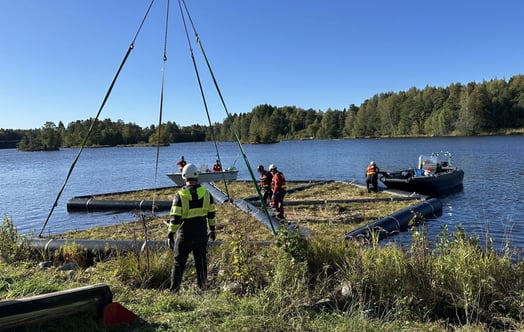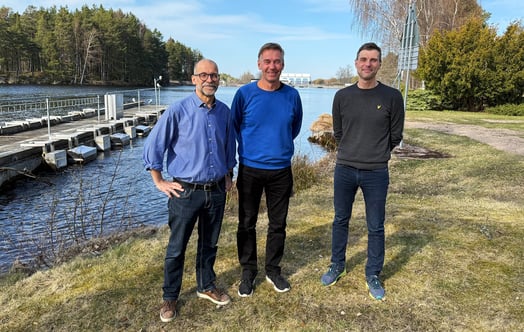Vattenfall to supplement hydro power with solar power
There is a potential for solar power of up to five megawatts in total at Vattenfall’s pumped storage plants in Germany, and the first project has now been launched at the pumped storage plant in Geesthacht near Hamburg.

Aerial photo of Geesthacht pumped storage plant with solar plant to the left of the water pipes
Vattenfall is further expanding its solar electricity generation and is currently checking the extent to which areas at the company's German pumped storage plants are suitable. As part of the so-called pv@hydro project, Vattenfall experts are currently determining the potential for around five megawatts of new solar power generation in total. This includes free space at the pumped storage dams, photovoltaic systems on the roofs of operating buildings as well as free space on previously unused areas.
The pv@hydro project has started at the Geesthacht pumped storage plant on the Elbe in Schleswig-Holstein, not far from Hamburg. The existing solar modules have been replaced with new, higher-performance modules as part of a repowering scheme and on top of that the plan is to install further photovoltaic modules with an output of close to 2 MW at the upper reservoir dam in Geesthacht. Additional photovoltaic systems may later be added to the pumped storage plants in Wendefurth (Saxony-Anhalt), Hohenwarte (Thuringia) and Markersbach (Saxony).Peter Apel, CEO of Vattenfall Wasserkraft GmbH: "Vattenfall aims to be fossil free within one generation. That's why it makes sense for us as a company to further promote the expansion of renewable energies, particularly in regions where we have already been a firm part of the local energy infrastructure for decades through our pumped storage plants."
At present, the solar energy is thus not used to operate the pumps at the pumped storage plant but fed into the grid through the pumped storage plant’s existing grid connection.
Claus Wattendrup, Head of the Solar & Batteries unit at Vattenfall, adds: "We find very good conditions for the construction of photovoltaic systems at the pumped storage plants. The use of the existing technologies leads to synergies that can also benefit the profitability of such projects. PV@hydro is an excellent example of how the existing and new energy worlds can be combined within the scope of the energy transition in Germany."
Along with the projects in Germany, Vattenfall has further solar projects in the pipeline or already underway, in particular in the Netherlands. In total, the company is building around 30 MW of new photovoltaic facilities in 2018. Vattenfall plans to invest some €100 million in expanding solar energy in 2018 and 2019.
What is a pumped storage plant?
With a pumped storage power plant, excess electricity generated in the electricity system can be used to pump large amounts of water from a lower reservoir to an upper reservoir where it is stored as potential energy. When additional electricity is needed in the system, for instance at times of peak demand, water can be released from the upper reservoir through the huge water pipes that also brought it up to the upper reservoir and used to propel the turbines installed at the lower reservoir. In contrast to hydro power plants located in rivers there is no natural inflow to the upper reservoirs of pumped storage plants. They consequently have a constant, limited storage capacity.
Why use pumped storage plants?
The capacity of the wind power plants and solar plant installed in Germany is continuously increasing. Thanks to the further expansion of the renewable energy sources, there will be an increasing need for storage capacity as well as the short-term availability of balancing energy to stabilise transmission networks in future.
Vattenfall pumped storage plants in Germany
Hydro in Germany operates eight pumped storage power plants. Vattenfall’s market share in total installed pumped storage plant capacity in Germany is roughly 40 % (3,000 MW of 7,000 MW in total).
Bleiloch 80 MWe
Geesthacht 120 MWe
Goldisthal 1,060 MWe
Hohenwarte I 64 MWe
Hohenwarte II 320 MWe
Markersbach 1,050 MWe
Niederwartha 40 MWe
Wendefurth 80 MWe



